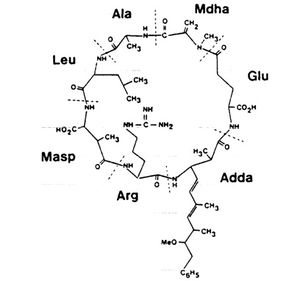Microcystis aeruginosa and the Effects of Microcystin-LR on Ecosystems and Human Health: Difference between revisions
| Line 27: | Line 27: | ||
Include some current research, with at least one figure showing data.<br> | Include some current research, with at least one figure showing data.<br> | ||
<br> | <br> | ||
[[Image:microcystinLR.jpeg|thumb|300px|right|The structure of microcystin-LR. Macintosh <i>et al.</i> 1990. [http://onlinelibrary.wiley.com/doi/10.1016/0014-5793(90)80245-E/epdf ]] | |||
==Dangers to Human Health== | ==Dangers to Human Health== | ||
Revision as of 19:32, 23 April 2016
Introduction

By Lauren Michael
At right is a sample image insertion. It works for any image uploaded anywhere to MicrobeWiki.
The insertion code consists of:
Double brackets: [[
Filename: PHIL_1181_lores.jpg
Thumbnail status: |thumb|
Pixel size: |300px|
Placement on page: |right|
Legend/credit: Electron micrograph of the Ebola Zaire virus. This was the first photo ever taken of the virus, on 10/13/1976. By Dr. F.A. Murphy, now at U.C. Davis, then at the CDC.
Closed double brackets: ]]
Other examples:
Bold
Italic
Subscript: H2O
Superscript: Fe3+
The term “microcystin” refers to a group of liver toxins that are produced by many species of cyanobacteria. The name microcystin comes from the genus Microcystis, which is one of the most widely know genera that produce this widespread toxin. Microcystis aeruginosa is one of the most common producers of microcystin, and is often associated with eutrophic fresh water systems, where they form large, toxic blooms, though they have been found in marine environments as well. Microcystin contaminated water poses a major health risk for both humans and animals, and has been known to cause mass die offs in contaminated ecosystems as well as the disruption of major food webs.[1]
Microcystis aeruginosa

Microcystin-LR
Include some current research, with at least one figure showing data.

Dangers to Human Health
Include some current research, with at least one figure showing data.
Section 4
Conclusion
References
Authored for BIOL 238 Microbiology, taught by Joan Slonczewski, 2016, Kenyon College.
